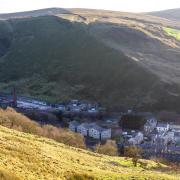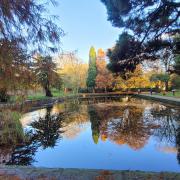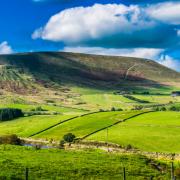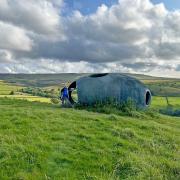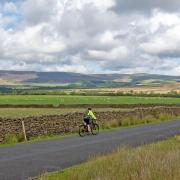While many people head north towards the Lake District for walking, the city of Lancaster has plenty on offer for ramblers.

How easy and enjoyable it is to get around Lancaster and its surrounding area largely depends on your mode of transport. If it involves four wheels, it can be slow going. But if you’re walking, it’s very pleasant - and good for you too.
Walkers in the city enjoy a wonderful resource in its canal. From the heart of Lancaster they can escape to its towpath for a quick stroll, or use it to access the fields and hills north and south, and via the Glasson Branch the coast to the west. And work is underway to improve this vital amenity.
With so much great walking close to hand it’s no surprise the city possesses many groups – large and small – dedicated to maximising those opportunities.
As is the case across Britain, walkers in Lancaster owe much to The Ramblers, who more than metaphorically paved the way for us to explore our countryside. Joy Greenwood, a founder member of The Lancaster Group of the Ramblers’ Association, says: ‘We formed in October 1969, so next year’s our 50th anniversary but we didn’t actually go walking at first. We’d formed to improve the footpaths here which were awful, so we went working not walking, and didn’t lead a group walk until 1975!’

They always go armed. ‘We still take secateurs with us every walk to get rid of brambles,’ adds David Johnson, the 260-member group’s secretary. ‘Once a month we do a footpath-checking walk in one of the 46 parishes we cover to make sure stiles, paths and signs are in good condition.’
Joy and David worry the local authority’s shortage of money may mean rights of way won’t be a priority, but acknowledge that Lancaster remains well provided for. ‘There are lots of short walks we do in the evenings – like Barley Cott Woods, a community woodland in Lancaster that takes in the canal, which is a great asset, and you can walk either side of the Lune, or go along the canal to Aldcliffe Old Drive, use the multi-user trail along the river to the quay,’ says Joy. And the Crook o’Lune, where we meet to talk, offers a variety of strolls or hikes in fabulous countryside.
‘The canal fraternity is developing the towpath trail, ultimately covering the full length from Kendal to Lancaster,’ explains Richard Trevitt, a past chairman of the Lancaster Canal Trust, ‘It already provides marvellous walking within the city, though you need to know your access points.’ Not unnaturally he recommends using the comprehensive guide to the canal produced by the LCT to get the most out of the resource, but for newcomers suggests strolling the area either side of the Waterwitch Basin as an introduction, or walking the two miles from there to the magnificent Lune Aqueduct.
On land adjacent to the aqueduct, volunteers working with the Canal & River Trust are working to create a small nature reserve complete with ponds: ‘We’re working to a six-year plan,’ says lead volunteer Stewart Hirst, ‘doing a little each year so as not to disturb the wildlife like the newts.’

‘It’s great to have an extra dedicated natural space that attracts wildlife to the canal,’ says Gemma Rathbone, a national officer with the C&RT, ‘and that in turn brings more people to walk here and enjoy it – walking is important to the canals overall.’
It’s a proven strategy, as their colleague, Waterway Supervisor Roy Gibbons explains: ‘Last year we had a merlin – our smallest bird of prey – here, and hordes of birders arrived to see it.’
Lancaster City Council recognises the value of walks and walking on several fronts: ‘We get 7.3 million visitors a year,’ says Darren Clifford, cabinet member for leisure and tourism, ‘and a significant proportion of them come to walk round the city and district.’ The council is keen to promote walking for health purposes too, he and a number of council colleagues currently showing the way by wearing pedometers and targeting 10000 steps a day. ‘Health improvement is a major priority for the council, we’re very aware of life expectancy issues in the North, so we’re trying to encourage people to walk to improve health outcomes,’ says Darren.
Steve Shackleton and his companions in the Lancaster & Morecambe Walking and Social Group need no persuading about the efficacy of hiking. ‘We go all over – the South Lakes, Dales, the Howgills, Trough of Bowland… sometimes we’ll travel up to 50 miles, or when it’s cold may just go to Hornby, say, and walk by the river there.’ The group, in its 30th year, avoids formality. ‘Bigger clubs in this area are highly organised. You need to book a coach seat in advance and pay even if you cry off. There are only about 20 of us, though it’s growing. We have a programme of walks but meet on the day and fill a few cars, then always have a cup of tea after the walk and decide how much we owe the drivers.’
Take a hike
Gregory Wright’s day job is at Lancaster Museum, but in his time off he runs Lancaster Walks, Talks and Tours. ‘I’ve been a guide for over 20 years,’ he says, ‘so I can offer a varied programme of themed walks – this winter it was mainly Hauntings, Hangings and Horrid Happenings, people love the grizzly stuff.’ He explains Lancaster Castle enjoys the dubious honour of being the place in England where more people have been sentenced to death than anywhere other than the City of London, so there’s no shortage of gore.
His other tours have included ‘Luck to Loyne’, covering 2000 years of Lancaster’s history; another that focuses on the city in the 18th century, slavery links and all; and 90 fascinating minutes spent exploring the small area around the castle, taking in well-known names like architects Paley and Austin, furniture makers Gillow, the rivalry between industrialists Storey and Williamson, the city’s one-time importance in stained glass making, and much more.




